As the years have passed, food has gone from being something to survive on to something to enjoy to the fullest. This is especially the case with pork meat.
Pork is the most popular meat worldwide. About 4 out of 10 meat products are made from pork. This means that many people think pork is delicious!
Pork has a unique texture, and it is also juicy and tender. But not all pork is alike. There are specific breeds that are known to taste more pleasant than others.
Today’s pork buyers and consumers prefer old-fashioned flavored pork from healthy pigs that are raised humanely. You must do your research on different breeds of pigs and how they taste before deciding which breed you prefer!
Table of Contents
What Makes Pork Taste Good?
Several factors determine how likely consumers are to buy a specific cut of pork. How the pigs were raised, what type of food they were fed, and under what circumstances they were slaughtered all make a difference to consumers’ willingness to purchase the meat.
Therefore, constantly improving and enhancing the quality of pork is crucial for the pork industry to survive and thrive.
Visual characteristics such as the color of the meat, the fat content of the meat, and the marbling of the meat are very important.
The pork’s texture also makes a difference. Pork that is overly soft, pasty, or crusty is considered low quality.
The breed of pig, diet, and living conditions determine the above characteristics. All of these things need to be perfectly controlled in order to get tasty, high-quality meat.
Another important factor is the flavor of the pork. The flavor is determined by how long the meat was cured and in what manner it was cooked.
According to certain pork connoisseurs, pork that is aged for 6-10 days tastes superior to pork only aged for 1-2 days. Properly aged pork has a sweeter, caramel-like taste.
It is also important to keep in mind that a pig’s genetics are another factor that affects the flavor of the pork. Certain genes affect flavor and juiciness.
The 16 Most Flavorful Pig Breeds
When listing the best-tasting pig breeds, we considered consumers’ preferences.
Some buyers prefer fatty flesh and ultra succulent old-style pork, such as that from Mulefoots, Guinea Hogs, and Mangalitsas. Others prefer leaner pork types, such as Poland Chinas and Durocs.
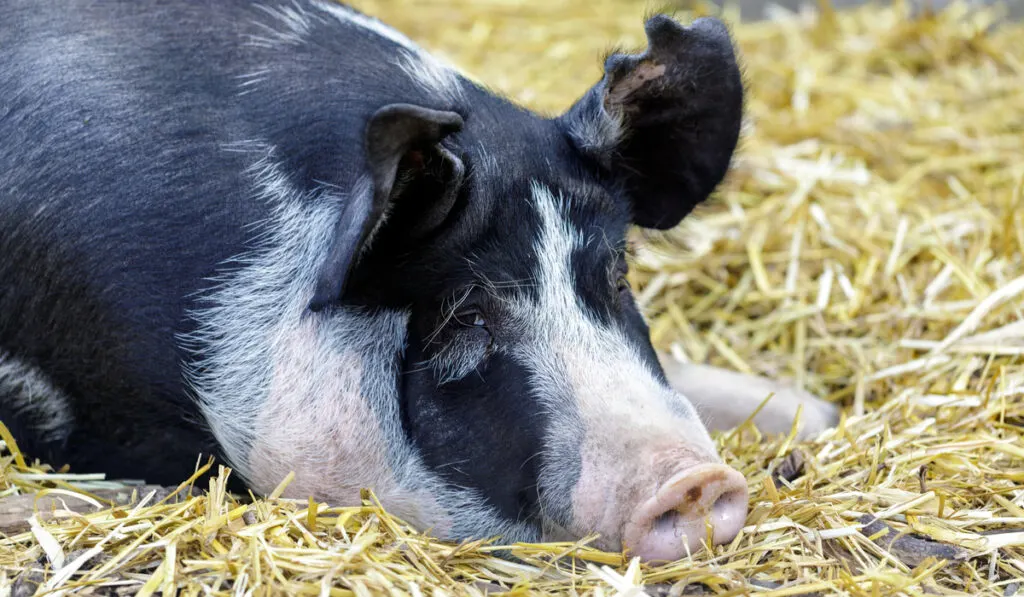
1. Berkshire
Berkshire pigs are renowned for meat that is juicy, marbled, and tasty.
While Berkshire hogs originally come from Berkshire, England, they are popular with Japanese chefs. In Japan, Berkshire pork is called “kurobuta,” which means “black pig meat.”
Aside from yielding tasty meat, these pigs are hardy, and they grow quickly.
Berkshire pigs are average in size, with a black coat and white patches on their tail, legs, and nose. They have dish-like faces and short, upright ears.
2. Chester White
Chester whites were bred in Chester County in the 1800s.
Chester whites are enormous, and they have floppy ears. They also have long bodies, which makes for extra-large hams! They yield lean, marbled pork.
Their thick coats make them suitable for pasture raising. They mature quickly and have a peaceful nature, making them ideal for farming.
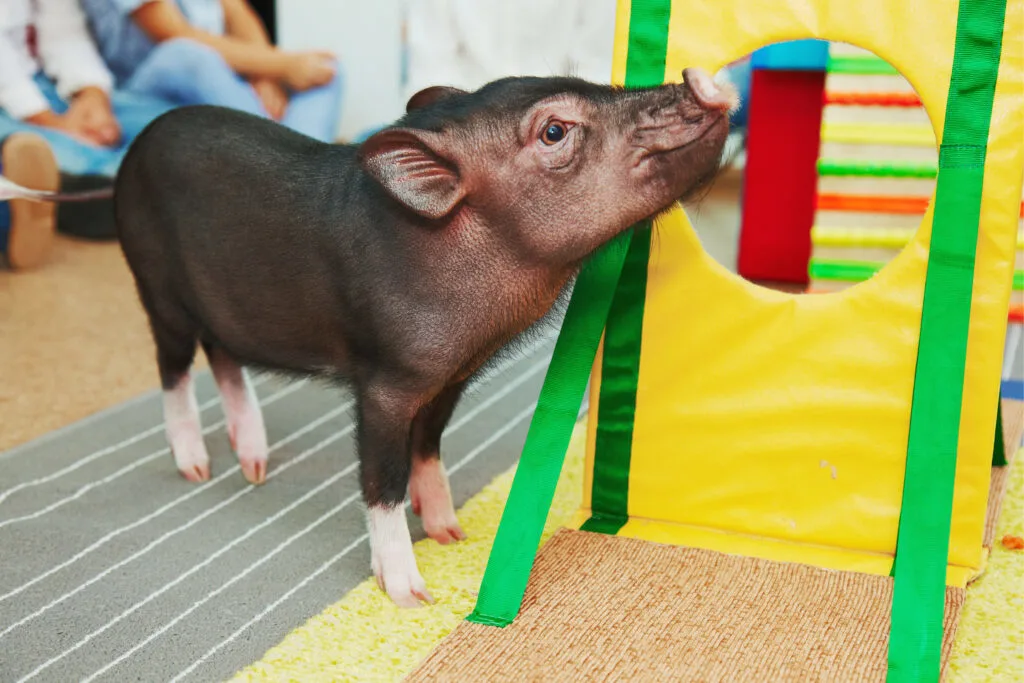
3. Choctaw
The Choctaw is a lard hog that Spanish explorers brought to America many years ago.
Did you know that only 100 Choctaw pigs remain today? So they aren’t readily available on the market to pork producers.
Thanks to The Livestock Conservancy, the Choctaw pig breed may be able to recover from its near extinction. When it does, it can become available to producers.
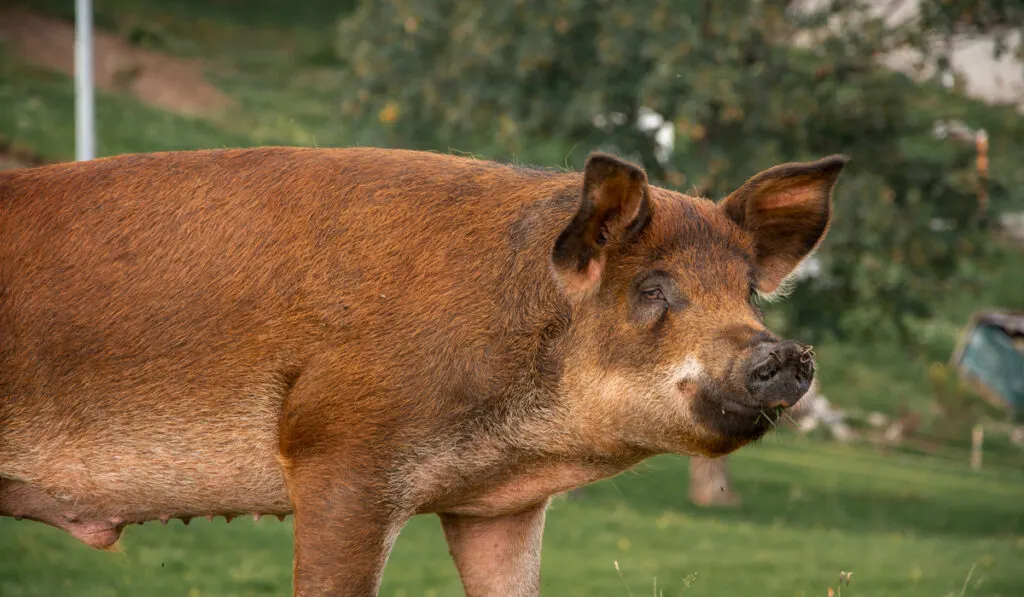
4. Duroc
New England swine breeders bred these big, red hogs in the 1800s.
Duroc hogs produce one of the tastiest lean marbled meats. They also grow quickly, yielding an efficient feed-meat turnaround that is appealing to commercial producers. It didn’t take long for the Duroc breed to be exported worldwide.
Today, this breed is a significant component of the North American pork industry.
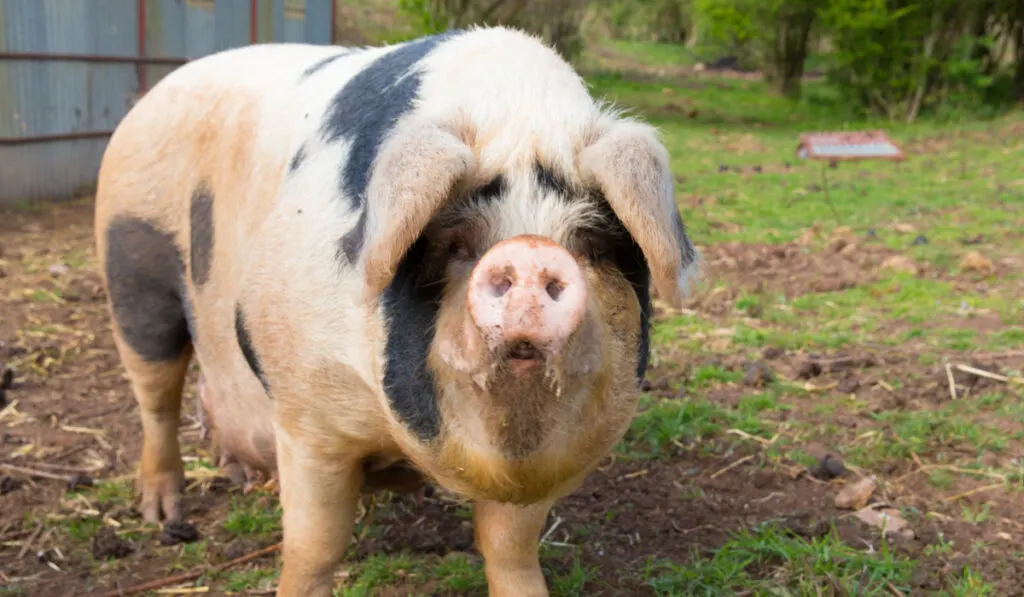
5. Gloucestershire Old Spots
Gloucestershire Old Spots. As you can tell from the name, this English breed has an interesting background.
Gloucestershire Old Spots used to be called Orchard pigs because they were fed windfall apples. They are sweet-natured, hardy, and excellent foragers.
Their appearance also has character: large ears droop over their face, their back is long and arched, and they have a white coat with black spots.
Gloucestershire Old Spots are known for their sweet, marbled meat and their ability to yield huge hams. The English royal family seems to approve of this pork; they still raise this breed.
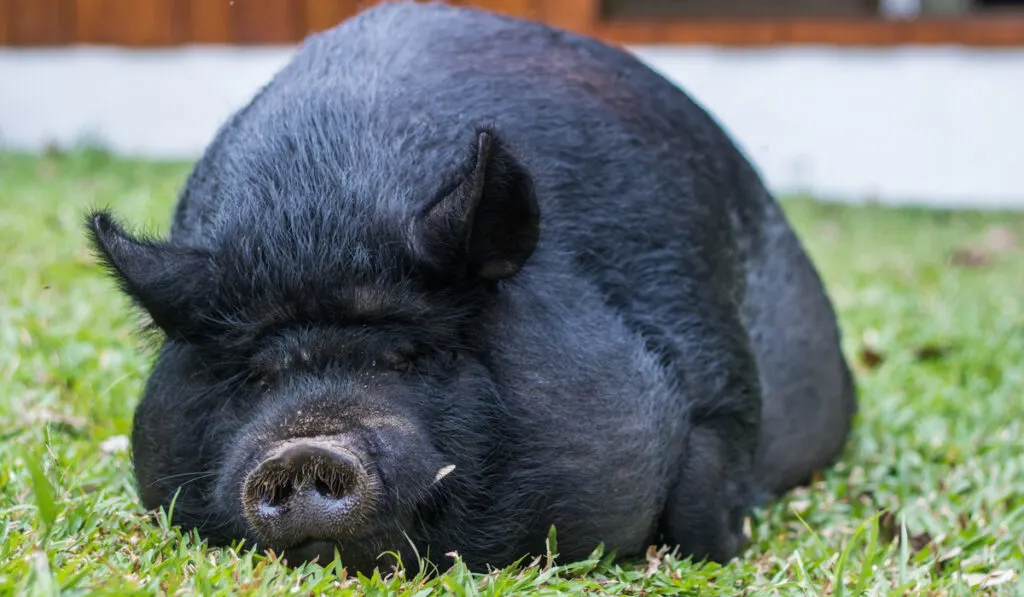
6. Guinea Hog
Guinea hogs have been a staple in the South for over two hundred years, thanks to their tasty meat. They are hardy and good at foraging, so they are ideal for pork producers.
Typically, an adult Guinea hog weighs around 150 to 250 pounds. They have black or red coats, straight or floppy ears, and short or long snouts.
They are a lard breed, so they produce fatty meat when raised in confinement.
This breed is listed on Slow Food USA’s “Ark of Taste” since Guinea hogs are a heritage breed in danger of extinction.

7. Hampshire
Hampshire pigs used to be called “Thin Rinds” due to their long, lean body. Kentucky breeders developed these pigs to have erect ears, a dished face, and a slightly curved back.
These pigs are both docile and hardy, and they grow quickly. Hampshire pork has little fat and is considered mild in taste.
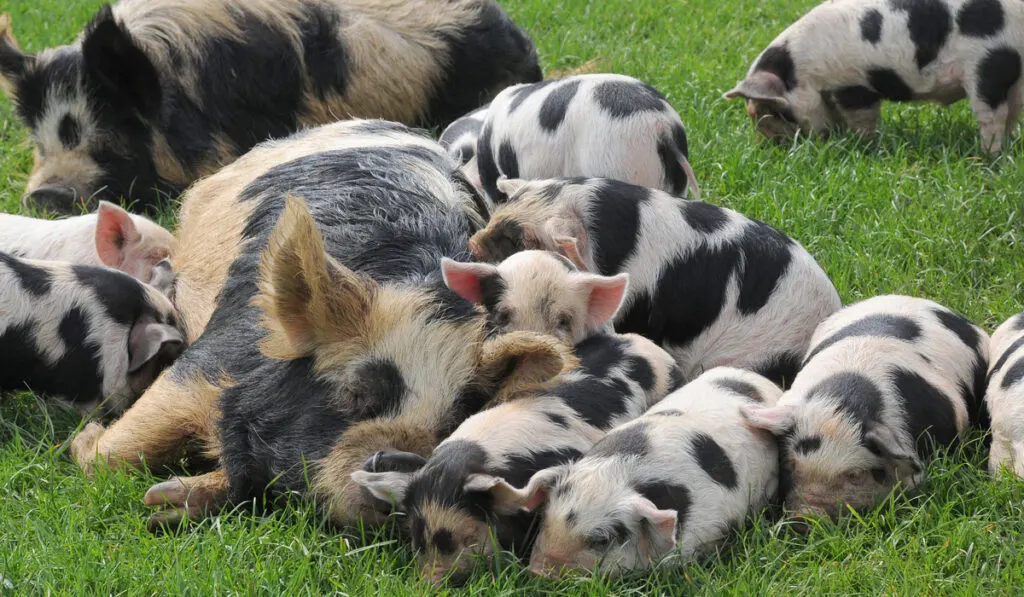
8. Kunekune
Kunekune pigs are small, so many consider them to be house pets. But this breed produces quality meat. In fact, the Maori have been raising this breed for meat since the 1800s.
Kunekune is a Maori word that translates to “fat and round,” so you can imagine how tasty their pork is! Kunekune pork is tender, juicy, and perfectly marbled.
Kunekune pigs are multicolored and have half-erect ears and very short legs. They also have short snouts, so they root less than other breeds.

9. Large Black
Large Black pigs are very big, with black or gray coats, long snouts, and floppy ears. These English pigs come from Devonshire and Cornwall counties.
Large Blacks are known to be tough and calm. They have decent foraging skills and, most importantly, produce delicious marbled meat.
10. Mulefoot
Mulefoot pigs are unique in appearance, with appendages on their necks known as wattles. They are medium in size, with black skin and fused hooves (just like a mule).
Their origin is unknown, but they were common in the Midwest and the Ozark region. In fact, in 1910, the National Mulefoot Hog Record Association was formed in the Ozarks. They recorded 235 breeders from 22 states.
Mulefoot pigs are hardy, amicable, and good foragers. They fatten easily and yield highly moist, marbled red pork.
11. Ossabaw Island Hog
Around 400 years ago, Spanish explorers left the progenitor of the Ossabaw Island hog on Ossabaw Island. A feral breed resulted and, to this day, remains untouched by artificial breeding.
Ossabaws are rough, and they’re excellent foragers. They carry a gene that allows them to gain a lot of weight. They can weigh between 100 and 250 pounds, and they use this fat to survive when food is scarce.
Their spicy, red pork is popular with chefs.
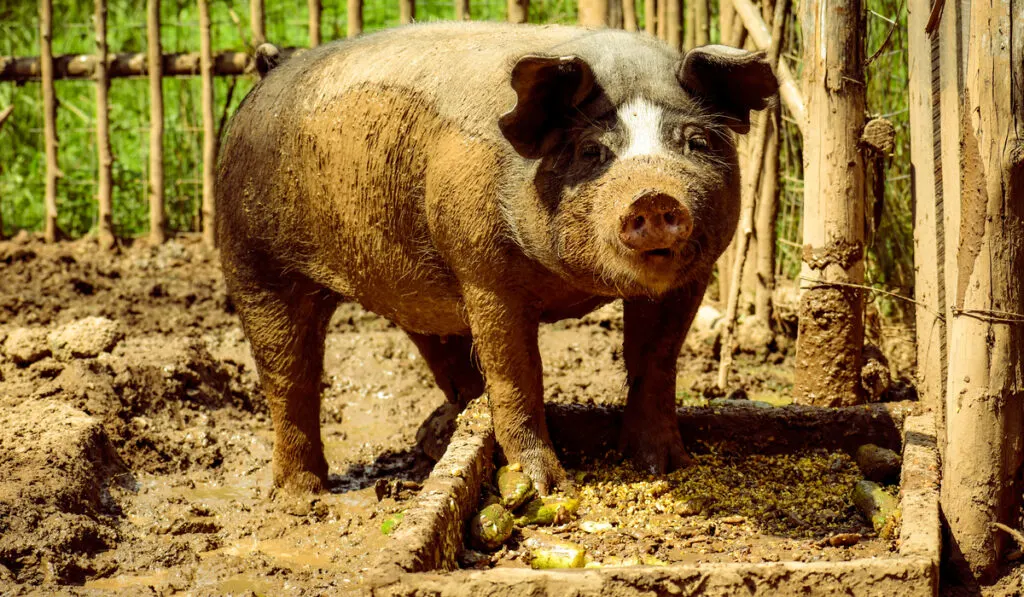
12. Poland China
Poland China pigs look like Berkshire pigs with their black skin and white snouts, legs, and tails. They were also developed in the 1800s but in Ohio’s Butler and Warren counties.
These long, lean pigs have big jaws but short snouts. They are docile but can handle rugged conditions.
Poland China pigs mature quickly and produce lean, marbled pork.
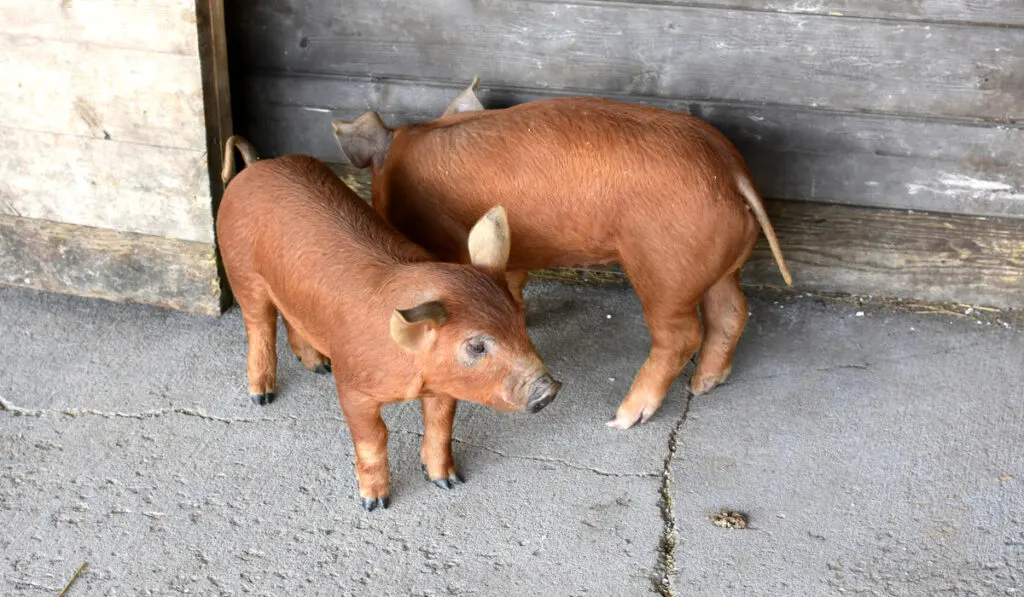
13. Red Wattle
The ancestors of the Red Wattle were hogs with wattles that roamed wild in East Texas. Red Wattles are very big, so they need more space than smaller breeds.
Red Wattles are easy to raise; they’re rough and tough with great foraging skills. They produce lean pork that is fine and luscious. Red Wattles are another breed listed on “The Ark of Taste.”
14. Spotted
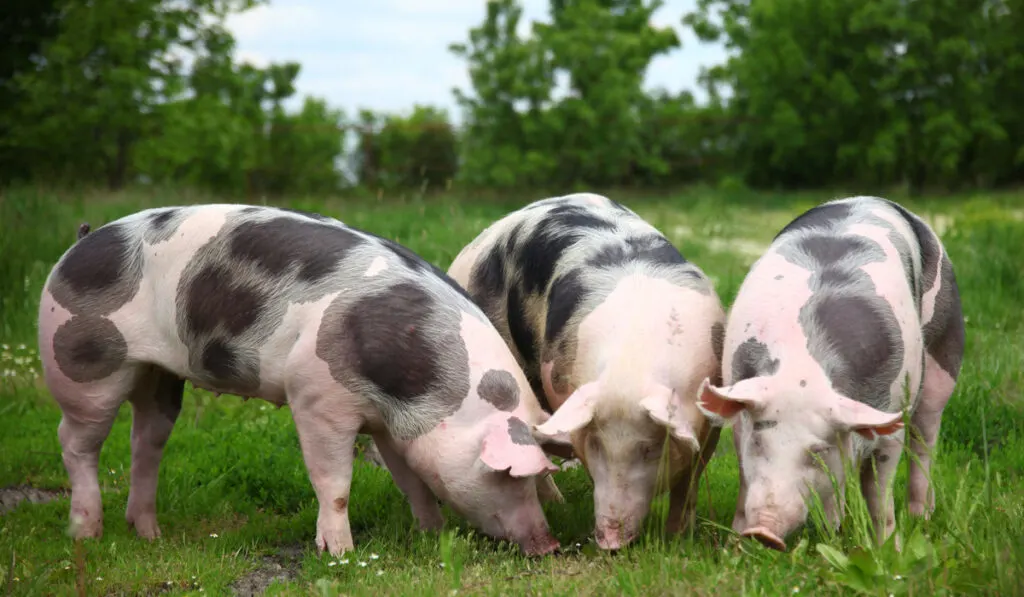
If you breed landrace hogs, Poland China pigs, and Gloucester Old Spots, you’ll get the Spotted pig. That’s exactly what farmers did in the 1800s when they produced this breed. They used to call them Spotted Poland China pigs.
Unsurprisingly, Spotted pigs are black and white spotted.
Spotted pigs are large, easygoing, and don’t require as much feed as other breeds. They produce yummy lean pork.

15. Yorkshire
Yorkshire pigs come from Britain. They used to be called Large Whites since breeders raised these hogs to be huge.
A certain four-year-old boar measured over 9 feet long and weighed a whopping 1,334 pounds. Its belly was about 8 feet in circumference.
Yorkshire pigs are muscular but have thin bones and fine, soft hair. Their pork is regarded to be prestigious, lean meat.
16. The Mangalitsa
The Mangalista is another breed that was developed in the 1800’s, this time by Hungarian farmers. The breed was Hungary’s top breed for over 100 years, and the salami, bacon, and lard from these pigs became prized all over Europe.
This breed of pig is a wooly-coated, slow-growing animal with very short legs. They create a cute pig with their floppy ears and short upturned snouts. Their meat is popular amongst chefs working in high-end restaurants, and they enjoy cooking and serving Mangalitsa’s dark, sweet, juicy pork.
Mangalistas look very different from other pigs. They have wooly coats! Their ears are floppy, and their snouts point upwards.
Mangalista pork is dark, succulent, and sweet.
Mangalista pigs need the freedom to roam. While that helps them stay healthy, it means their meat is more expensive.

So Which Pork is the Best?
The winner is—Mangalista pork!
Here are factors that cause Mangalista pork to be considered the tastiest pork worldwide:
- intramuscular fat
- richer meat
- stricter breeding programs
- higher quality standards
- raised and bred for flavor
- farmers focus on quality, not quantity
- processed by artisan butchers
Mangalista pork is expensive but 100% worth the cost.
Conclusion
When it comes to the best-tasting pig breeds, it is clear that they come from all over the world. The smallest things can affect the taste of a simple pork chop. It is always good to know what type of pork you are enjoying and why it tastes so terrific!
Resources
- https://www.npr.org/sections/thesalt/2015/07/20/423865233/why-the-pig-is-the-most-loved-and-most-loathed-animal-on-the-plate
- https://artofeating.com/the-lost-taste-of-pork/
- https://www.thepigsite.com/articles/consumers-and-pork-quality-sensory-taste
- https://acornblufffarms.com/blogs/our-blog/2019-1-11-why-is-mangalitsa-the-worlds-best-tasting-pork-more-expensive
- https://www.thepigsite.com/articles/pork-meat-quality-understanding-industry-measurements-and-guidelines
- https://www.hobbyfarms.com/17-pastured-pig-breeds-to-raise-for-flavorful-pork/
- https://genesus.com/consumers-pork-quality-sensory-taste
